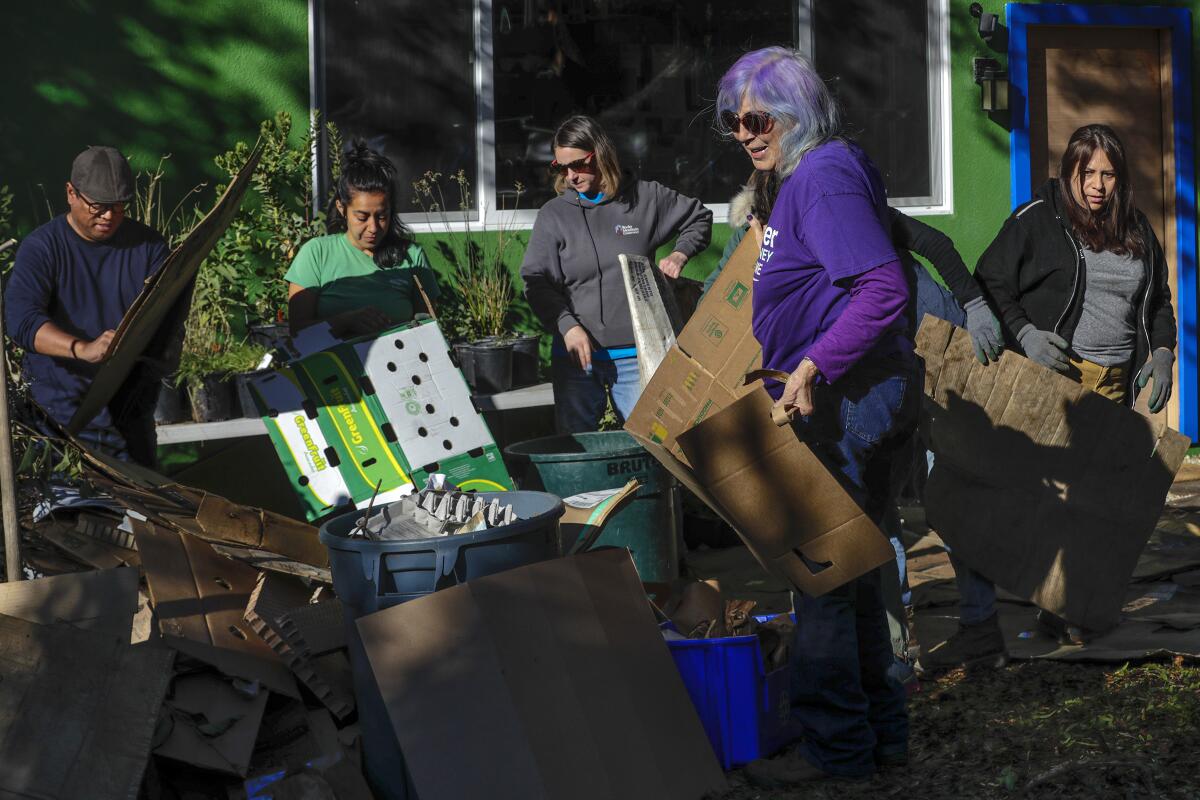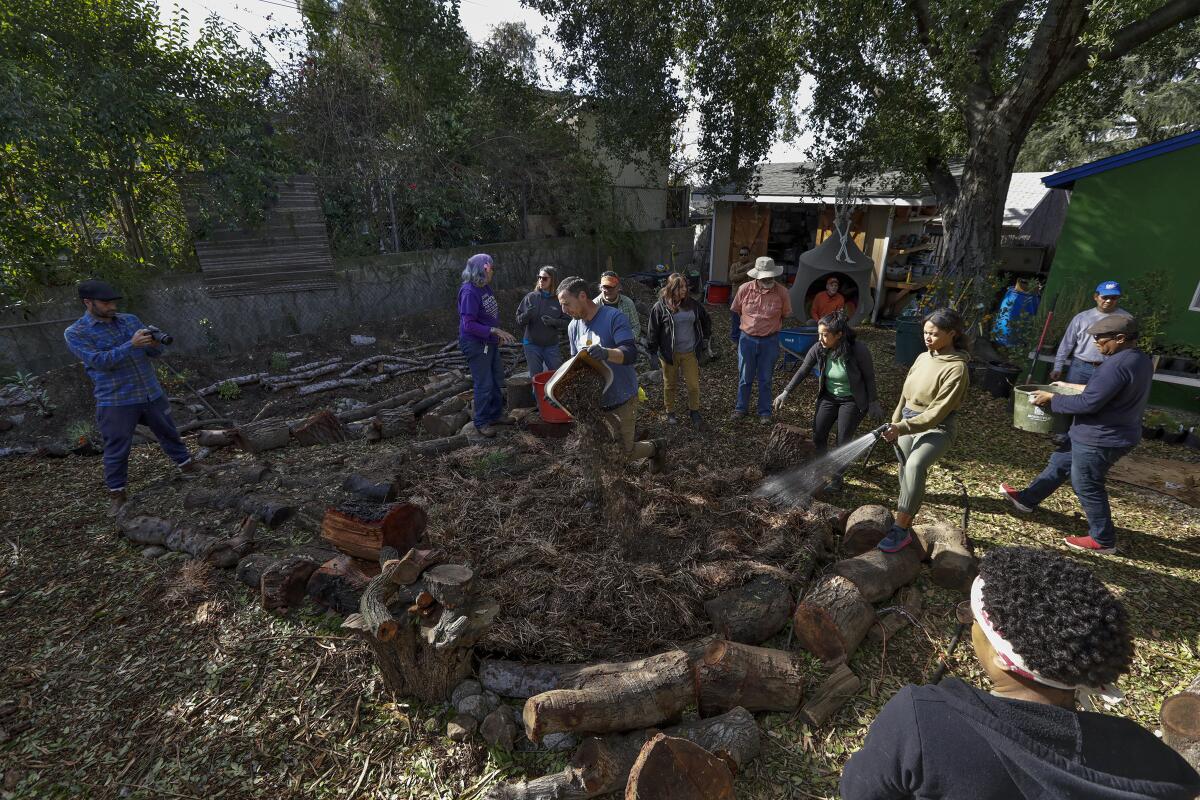Sign up for The Wild
We’ll help you find the best places to hike, bike and run, as well as the perfect silent spots for meditation and yoga.
You may occasionally receive promotional content from the Los Angeles Times.

Lasagna mulching is kind of a miracle, the closest thing to an easy fix for lousy garden soil, suppressing weeds and rebuilding our disappearing topsoil.
Added bonus: The vital starting ingredient — cardboard — is available for free, in mass quantities, from grocery stores, dumpsters and recycling bins.
Not convinced? Just check the lush growth at the L.A. Arboretum’s Crescent Farm, where six years ago a group led by artist-in-residence and interpretive horticulturist Leigh Adams converted nearly an acre of compacted old lawn, overrun with nut grass, into a croissant-shaped, water-wise garden of edibles, native plants, wildflowers and trees.

Arboretum botanists were a little dubious too, in the beginning, said Adams, a 70-year-old sprite with purple glasses and hair, “but now the county has claimed this as one of its best management practices. It’s really gratifying to have that change take place while I’m here.”
“I was show-me skeptical,” admits botanist Frank McDonough, who works as Los Angeles County’s botanical information consultant at the Arboretum, advising anyone with questions about plant-related matters. “I’m not an expert on the actual technique; I just know the theory behind it and I know it works.”
How to know if the tree in your yard is sick or dying, and how to deal with it.
The key to creating beautiful soil is to attract beneficial microbes, such as mycorrhizal fungi, which help roots pull the moisture and nutrients they need from the soil to grow healthy plants. And it turns out that mycorrhizal fungi love the cellulose and glue in cardboard, the same way children love sugary cereals, Adams said.
The beauty of the “lasagna” process is once you assemble your materials, you can have excellent plantable soil within a day, Adams said. And many of the ingredients — cardboard, leaves, lawn clippings, stable bedding, homemade compost and wood chips — are items you can collect for free from around your own home, your neighbor’s yard or your friendly neighborhood tree trimmers, who would rather leave their wood chips in your yard than pay to dispose of them at the landfill.
Here’s the recipe.

This is your first and non-negotiable ingredient—the “noodles” in your “lasagna,” crucial because it is dense enough to suppress weeds and grass while attracting the mycorrhizal fungi that will create a delicious, nutritious soil for your plants.
Start collecting and breaking down boxes from friends and family, dumpsters, grocers and retail stores. (Just don’t use cardboard with a shiny finish.) Pizza boxes usually can’t be recycled, but they can be used in your lasagna mulch. And if you’re covering a large space, try to find big boxes from stores that sell appliances, bicycles and/or drapes.
Either way, collect double what you think you’ll need, because you’ll use it all and still wish you had more, Adams said.
Angelenos have already trained themselves to bring reusable bags on grocery store runs. Are reusable bottles next?
WARNING: Do not use purchased sheet cardboard, Adams said. Arboretum officials were horrified to discover Adams dumpster-diving for boxes, so they purchased agricultural cardboard, which seemed perfect because it came in flat sheets, she said. But the sheets curled and dried out, and she discovered they didn’t have the tensile strength and ingredients that makes waste cardboard so attractive to fungi.
“Cardboard boxes have more fiber in them and glue, all arranged in neat little rows with oxygen traps, and no fungi can resist that,” she said. “Think of it as a birthday party for your fungal starts, because mycorrhizal fungi metabolizes glue as a sugar.”
Break down the boxes, removing tape and staples, and then lay them flat on the space you want for your garden, whether it’s bare soil, weeds or grass. Be sure to overlap the cardboard so there are no exposed areas, Adams said. If you are covering grass, Adams recommends digging out the grass around the edges of your space, about 8 inches in and 6 to 8 inches deep, so the cardboard can cover the remaining grass completely.

Getting the cardboard wet before you add the other ingredients helps start the decomposition/composting process in your new soil. Step on the cardboard as you wet it down so it conforms to the shape below, and don’t be afraid to create mounds and contours in your yard. Flat yards are “an artifact of the lawn mower,” Adams said. “Creating a curvaceous surface is sexier, gives you more planting area and captures more rainwater because it has highs and lows.”

Here is where your other layers come in. Your goal is to have at least 8 inches of green waste/mulch covering that cardboard; Adams said she’s done layers as tall as 18 inches. And remember you’re basically creating a kind of large compost pile, so you want layers of carbon (such as dry leaves, shredded newspaper, straw bedding and wood chips) and nitrogen (such as grass clippings, kitchen scraps, coffee grounds and compost).
Recycling is good. Not using new material in the first place is better. Reduce single-use plastic and paper products with these sustainable alternatives.
If you use grass clippings, apply them lightly, mixed in with other materials, so they don’t get matted and form a barrier that repels water, Adams said. And if you use newspaper, shred or crumple the paper so it doesn’t mat and block oxygen to the soil. Straw mostly adds oxygen to the soil, she said, but straw bedding is even better because it includes the added punch of aged manure and urine. Adams recommends against using bedding from racetracks, however, because of the drugs that racehorses are given.
After a layer of carbon and nitrogen, add more cardboard, if you have enough, wet it down and then cover it thickly — about 8 inches worth — with a mulch of wood chips or leaves.
If you prefer to buy mulch, Adams’ favorite place is Cal Blend Soils in Irwindale, but she also recommends talking to local tree trimmers about leaving their wood chips in your driveway and using that for your mulch. Just make sure you know what kind of trees they’re trimming, because seeds from Trees of Heaven (Ailanthus altissima) and palm trees sprout easily and are quite invasive.
Sign up for The Wild
We’ll help you find the best places to hike, bike and run, as well as the perfect silent spots for meditation and yoga.
You may occasionally receive promotional content from the Los Angeles Times.